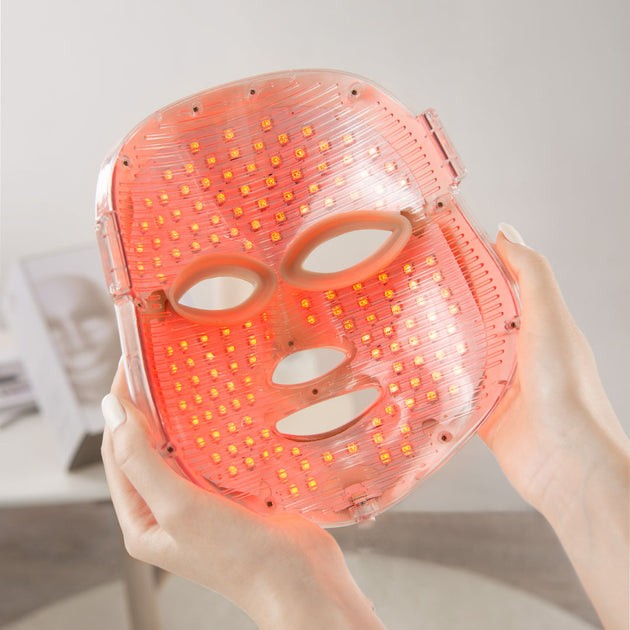
Red and Blue Light Therapy: The Perfect Duo for Radiant Skin Contents
Share
Contents
-
Understanding LED Light Therapy
-
Red Light: The Anti-Aging and Repairing Ally
-
Blue Light: The Acne-Fighting Solution
-
What’s the Difference Between Them?
-
Why Combine the Two?
-
The Benefits of Red + Blue Light
-
Scientific Evidence
-
Key Takeaways
Reading time: about 4 minutes
1. Understanding LED Light Therapy
LED light therapy uses different wavelengths of light to stimulate the skin and improve its overall condition.
Each color penetrates at a specific depth, triggering natural biological responses such as renewal, repair, or purification.
Some LED devices even go beyond visible light, using infrared wavelengths that reach deeper tissues, muscles, and nerves.
But which color works best? In reality, the combination of red and blue light often delivers the most balanced and visible results.
2. Red Light: The Anti-Aging and Regenerating Ally
Red light (630–700 nm) penetrates deeply into the skin.
It activates the mitochondria, the cell’s energy source, helping cells function more efficiently.
This stimulation boosts the production of ATP, which in turn increases collagen, elastin, and hyaluronic acid — the essential proteins that keep the skin firm, plump, and youthful.
Benefits of red light therapy:
-
Reduces fine lines and wrinkles
-
Improves skin texture and tone
-
Speeds up wound healing
-
Strengthens the skin’s antioxidant defenses
It can even have positive effects on mood and sleep, thanks to its influence on natural biological rhythms.
3. Blue Light: The Purifying, Acne-Fighting Solution
Blue light (420–490 nm) works mainly on the outer layer of the skin (epidermis).
It acts as a natural antibacterial agent, destroying acne-causing bacteria while balancing sebum production.
Key effects:
-
Clears and prevents acne breakouts
-
Regulates oil glands
-
Soothes redness and inflammation
This makes blue light therapy ideal for oily or acne-prone skin that needs deep cleansing and calming care.
4. What’s the Difference Between the Two?
The main difference lies in their wavelengths and depth of action.
| Light Type | Wavelength | Skin Layer | Main Benefits |
|---|---|---|---|
| Red | 630–700 nm | Dermis (deep layer) | Wrinkles, firmness, healing, overall rejuvenation |
| Blue | 420–490 nm | Epidermis (surface) | Acne, oil regulation, inflammation, purification |
In short:
-
Red light regenerates and repairs.
-
Blue light purifies and balances.
Used together, they create a harmonized effect for complete skin health.
5. Why Combine the Two?
These two technologies are not opposites — they complement each other perfectly.
That’s why most high-end at-home LED masks include both red and blue light modes.
-
Blue light helps reduce inflammation and prevents oxidative stress, a major cause of premature aging.
-
Red light boosts collagen production and repairs tissue damaged by acne or scarring.
Used together, they target both the surface and deeper layers of the skin, delivering clearer, smoother, and more radiant results.
6. The Benefits of Red + Blue Light Combination
-
Stimulates cellular regeneration
-
Improves blood circulation and oxygenation
-
Reduces inflammation
-
Speeds up skin healing and recovery
-
Enhances overall radiance and balance
7. Scientific Evidence
Clinical studies strongly support the combined use of red and blue light therapy:
-
A 2006 study showed an 82% reduction in acne after just four weeks of combined treatment.
-
A 2015 study reported a 77% decrease in both inflammatory and non-inflammatory acne lesions after twelve weeks.
Researchers also found that the red + blue light combination was more effective than blue + infrared therapy for treating acne.
8. Key Takeaways
Red light promotes regeneration and firmness, while blue light purifies and prevents breakouts.
Together, they offer a complete and balanced skincare approach:
-
Blue light addresses the causes,
-
Red light repairs and strengthens.
Their synergy provides faster, deeper, and longer-lasting results, whether your goal is anti-aging, acne reduction, or an overall skin glow.
written by Charle Pill

